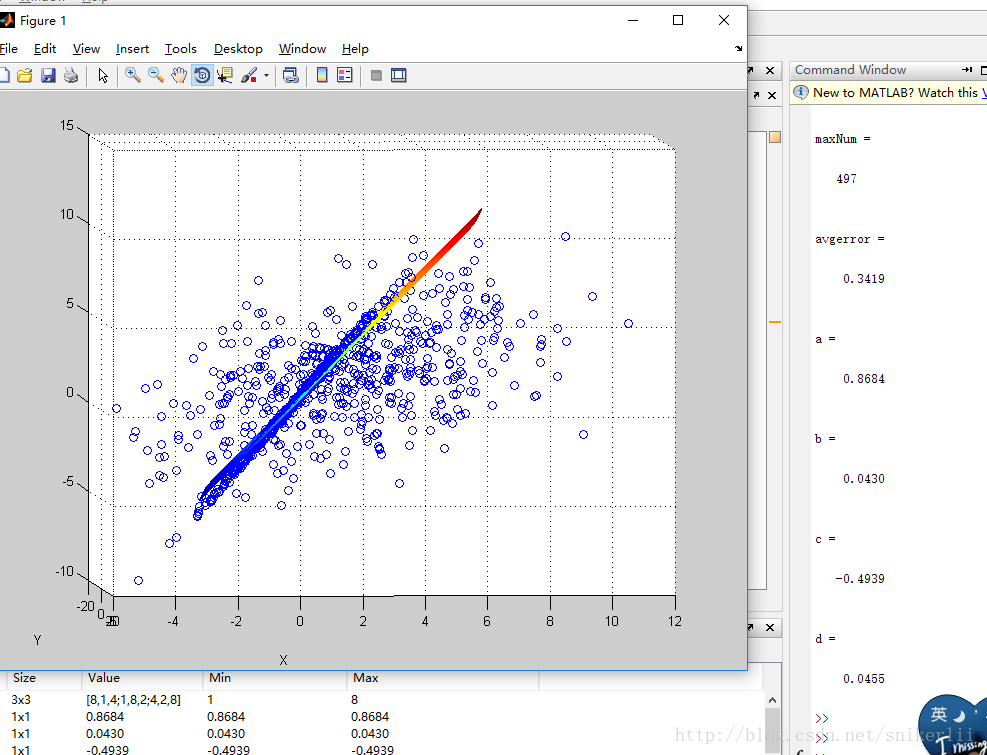RANSAC原理
输入:①数据 ②抽样次数N ③距离阈值t ④数量阈值T
输出:最终估计的模型
程序流程:
1. data :数据
2. 取样本 :确定模型参数p所需要的最小数据数n,随机取n个数据作为一个样本J
3. 建模型:根据样本J建立模型Mp(J)。
4. 判断距离:根据模型Mp(J)判断所有数据点到模型的距离。
5. 记录:记录 距离小于t的个数total 和 距离小于t的点的索引。
6. 判断: 若total>数量阈值T :则用距离小于t的点重新估计模型 重复3-5一次。
若total<数量阈值T:则跳出。
7. 记录最大total和此时的模型作为最佳模型。
8. 循环N次。
9.输出
函数ransac_fitplane
function [a,b,c,d]=ransac_fitplane(data,N,t,T)
figure;plot3(data(1,:),data(2,:),data(3,:),'o');hold on; % 显示数据
iter = N; %抽样次数N
number = size(data,2); % 总数
maxNum=0; %符合拟合模型的数据的个数
for i=1:iter %循环次数
sampleidx = randperm(number); sampleidx =sampleidx(1,1:3);
sample = data(:,sampleidx); %取样本
[a1,a2,a3,a4]=get_nice_plane(sample);%拟合直线方程 z=ax+by+c
plane = [-a1/a3,-a2/a3,-1,-a4/a3];%建模型
mask=abs(plane*[data; ones(1,size(data,2))]); %求每个数据到拟合平面的距离
total=sum(mask<t); %计算数据距离平面小于一定阈值的数据的个数
index= mask<t;
if total>T
nsample=data(:,index);
[a1,a2,a3,a4]=get_nice_plane(nsample);
plane = [-a1/a3,-a2/a3,-1,-a4/a3]; %z=ax+by+c
mask=abs(plane*[data; ones(1,size(data,2))]);
total=sum(mask<t); %计算数据距离平面小于一定阈值的数据的个数
end;
if total>maxNum %记录最大total
maxNum=total;
bestplane=plane;%最好的拟合平面
bestindex=index;
bestplane2=[a1,a2,a3,a4];
end
end
%显示符合最佳拟合的数据
maxNum %最大一致集
avgerror=abs(bestplane*[data; ones(1,size(data,2))]);
avgerror=sum(avgerror(find(avgerror<t)))/maxNum %计算一致集内平均误差
a=bestplane2(1);b=bestplane2(2);c=bestplane2(3);d=bestplane2(4);
% 图形绘制
temp1=data(1,bestindex);
temp2=data(2,bestindex);
xfit = min(temp1):0.2:max(temp1);
yfit = min(temp2):0.2:max(temp2);
[XFIT,YFIT]= meshgrid (xfit,yfit);
ZFIT = bestplane(1)*XFIT+bestplane(2)*YFIT+bestplane(4);
mesh(XFIT,YFIT,ZFIT);grid on;
xlabel('X');
ylabel('Y');
end
函数get_nice_plane
function [a,b,c,d]=get_nice_plane(data) planeData=data'; % 协方差矩阵的SVD变换中,最小奇异值对应的奇异向量就是平面的方向 xyz0=mean(planeData,1); centeredPlane=bsxfun(@minus,planeData,xyz0); [~,~,V]=svd(centeredPlane); a=V(1,3); b=V(2,3); c=V(3,3); d=-dot([a b c],xyz0); end
主程序
mu=[0 0 0]; S=[2 0 4;0 4 0;4 0 8]; data1=mvnrnd(mu,S,400); %外点 mu=[2 2 2]; S=[8 1 4;1 8 2;4 2 8]; data2=mvnrnd(mu,S,500); data=[data1',data2'];%% 相当于原始数据 [a,b,c,d]=ransac_fitplane(data,3000,0.5,300)
实验结果

